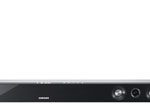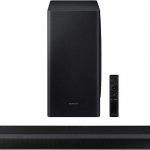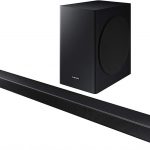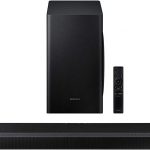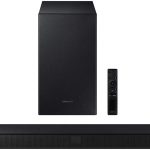The Samsung Hw-Q80R is among the latest mid-range soundbars in the company, and it’s just below the flagship of the Samsung HW-Q90R.
What is Samsung HW-Q80R?
Table Of Content
The two Samsung soundbars are somewhat similar with one exception: the Samsung HW-Q80R doesn’t have wireless rear speakers. Therefore, it’s missing the rear surround and overhead channel that grace the Q90R, and is limited to the two upward-, three front-and two side-firing drivers included on the soundbar.
Yet, the Q80R comes with a similar redesigned wireless active subwoofer as the more costly model. Thus, it can deliver a 5.1.2-channel immersive audio thrilling experience. It comes with the same features, which include support for DTS:X and Dolby Atmos, two HDMI inputs, Harman Kardon tuning, and an Adaptive Sound mode.
The HW-Q80R can be bought at £999, which is £500 cheaper than the HW-Q90R. It’s possible to add wireless rear speakers (SWA-9000S). But this will require more money, as they cost £149 a pair excluding the upward-firing drivers.
Design features
It’s almost identical to the HW-Q90R. It’s black with a slight sheen, a top front edge, and rounded corners. The HW-Q80R measures 48.5 (L) x 5.37 (D) x 2.34 (H) inches. And it has a substantial weight (19.4 pounds), which shows great construction quality. The sides, back and front of the soundbar are covered in the identical black metal grille and allow sound to pass without obstruction.
Behind the grille and front of the soundbar is a white dot-matrix LED readout indicating the setting for channel volume control, sound modes, and volume. All this can be easily adjusted using the Samsung curved black plastic remote that has the dual-brand Samsung Harman/Kardon soundbar label.
Additionally, the soundbar has places for physical control on top of the bar, which includes a touch-sensitive button for input selection, buttons for power, and volume.
The size of the bar portion of the system fits perfectly below a 65-inch Samsung display.
Connections and controls
The Samsung HW-Q90R has two HDMI inputs and an HDMI output. They all support Anynet+ (HDMI-CEC), 4K/60p, High Dynamic Range (Dolby Vision, HDR10 and HDR10+), and HDCP 2.2. The HDMI output supports audio return channel (ARC). Just as it is the case for Q90R, the number of HDMI inputs is disappointing. If Samsung added an eARC, the situation would be solved, but they haven’t delivered this promise yet.
The other available digital connection is the optical digital input, but in terms of wireless, you get Bluetooth and WI-FI.
On the underside, the soundbar has a USB port for service updates, a button for Wi-Fi setup, a connector for the two-pin power cable, and a button for pairing the wireless subwoofer and other speakers if need be.
The remote is also identical to that of Q90R. It’s sensibly laid off and easy to hold. And it has all the buttons you need to control the soundbar.
There are settings, Bluetooth pairing, play/pause controls, navigation controls, mute, volume, and sound notes (game pro, surround, standard, and adaptive sound).
Since the buttons have multiple functions, you can control your soundbar with your Samsung remote. You can also turn Anynet+ on or off, or skip music files backward and forward.
Other controls include completing the Id Set when connecting with an external item and turning the auto power link on and off. You can also reinitialize the soundbar or bring up a frequency of bands.
Samsung HW-Q80R Features & Specs
The HW-Q80R has the same features as the Q90R besides the lack of rear speakers. Even if you purchase the optional rear speaker pack to add surround channels, the Q80R is still limited to 7.1.2 processing since it lacks upward-firing drivers. This means that although the soundbar can decode Dolby Atmos and DTS:X, the results will be kind of front-heavy.
The Samsung HW-Q80R delivers 7.1.2 perfectly and uses many speakers all build around 13 drivers. The front three channels have three drivers each, and every speaker has a wide range of tweeter and two subwoofers. The nine drivers create a great front soundstage that’s amplified by two side-firing drivers to add width and two upward-firing drivers to add the overhead mediums.
All the 13 drivers in HW-80QR are powered by individual amplifiers that have a total of 372W. Samsung hasn’t disclosed how the amplification is divided among the drivers. The upgraded subwoofer uses most of the amplification, and the system has a frequency that goes from 34Hz to 17kHz with the subwoofer dealing with the lower frequencies.
The HW-Q80R is co-developed by Harman Kardon (a Samsung subsidiary) and Samsung Audio Labs. The subsidiary makes sure the sound is dynamic while maintaining a clear voice.
In regards to audio formats, the soundbar supports DTS:X and Atmos as well as decodes DTS-HD Master Audio and DTS Digital Sound along with Dolby TrueHD, Dolby Digital Plus, and Dolby Digital.
Adaptive sound mode is a feature that’s created to analyze the audio and process the sounds using the appropriate channels. This means if you are watching the news, the processing will emphasize the center channel for clear dialogue, while the left and right channels are left for music. Yet, all channels are used to improve the effects on a movie or crowds at a football match.
If you’re using Xbox One or PS4 through HDMI to a 2019 Samsung TV, there is a feature that detects your console using metadata and selects the low input lag game section on the TV. At the same time, the TV instructs the soundbar to tune in to the Game Pro sound mode. If you decide to switch from gaming, the TV and soundbar will switch itself from the game mode.
There is also a surround mode for film lovers. It upscales the content to utilize all available speakers, which include overhead channels. The mode works perfectly, producing an immersive experience by creating the impression there are overhead channels with 5.1 and 7.1 content. Lastly, the standard mode decodes the audio format without processing as 7.1, 5.1, and 2.1 when you add the optional rear speakers.
In terms of other features, there’s built-in WI-FI and Bluetooth that allows you to access your streaming services and music libraries. There is also support for many lossy and lossless audio formats that include ALAC, AAC, OGG, WAV, FLAC, and AIFF with high-resolution support up to 32 bits.
Samsung includes UHQ 32-bit upscaling for supporting gadgets.
Since the soundbar supports Samsung’s SmartThings App, it’s easy to set it up and control other devices. The soundbar also works with Amazon Alexa so you can control it hands-free, allowing you to listen to music through Spotify connect.
Setup and Operation
The Samsung HW-Q80R is very easy to set up. You only need to set up the soundbar below your TV and then place your subwoofer towards the front of the room. Ensure that nothing is blocking the side, and upward-firing drivers, so they can bounce sounds off the ceiling and wall.
The upward-firing drivers on the HW-Q80R hit the ceiling towards the front of the room, creating the front overhead channels. To get the desired results, the upward-firing drivers need a low, reflective, and flat ceiling to bounce sounds to you. The side-firing drivers are created to bounce off the sidewalls, causing the effect that there are speakers.
The subwoofer pairs automatically with the soundbar, designing a 5.1.2-channel system. Ideally, you’re supposed to balance the levels of all channels. But to do this, you should have DTS:X test disc or Atmos and an SPL meter. You can then proceed and set levels front top, side, center, and subwoofer channels.
The SmartThings app will help you in connecting with your soundbar very easily. Just download, install your app, and follow the simple instructions. Alternatively, you can pair the HW-Q80R to a Bluetooth device by pressing the Bluetooth button on your remote and selecting ‘Samsung Soundbar Q80R’ on the gadget.
If you’re using the latest Samsung TV, it will configure automatically. But if you’re using a TV from a different manufacturer, you’ll require an ARC to ensure the setup is right. You can use your TV remote, provided controller, or the SmartThings app. The latter enables you to play audio through a different Samsung gadget using Group play as well as control other smart home appliances.
If you already have an Amazon Alexa device, you can use your voice to control the Samsung HW-Q80R soundbar. Ensure you change the soundbar’s name on the app to a unique name such as Livy. Secondly, search for ‘Samsung Wireless Audio’ on the skill list of Alexia and activate it. You’ll then be able to control the soundbar with phrases like, “Alexa volume up on Livy.”
Pros and Cons of Samsung HW-Q80R
Advantages
- Well-made and pretty
- Great sound quality
- Dolby Atmos & DTS:X
- Well-integrated bass
Disadvantages
- Only two HDMI inputs
- Effects very front heavy
- Limited audio calibration
- No eARC
What are my alternatives?
The best alternative is Samsung HW-Q90R that delivers a full 7.1.4-channel immersive audio thanks to its wireless rear wires. The soundbar costs £500 more, but it’s the only one that can offer a genuine object-based experience, which makes it different. You can still go for the HW-Q80R, but you’ll need to add £150 more for the speakers. And you still won’t have upward-firing drivers at the rear.
Final Verdict
The Samsung HW-Q80R is a great clear, adaptive, and bright soundbar that will handle your television and movie sound with aplomb.
It also has multiple features that ensure access and listen to your favorite streaming and digital music collections.
Therefore, you can be sure of a sensational experience with the soundbar.


